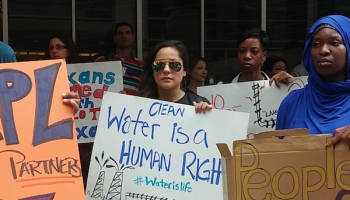Community anglers found toxic PFAS at high levels in 12 species of commonly-consumed fish, putting subsistence anglers at elevated risk
Ann Arbor, MI, February 23, 2023 —A new community-based study finds toxic PFAS present in every fish sampled from the Huron and Rouge rivers. The Ecology Center’s Healthy Stuff Lab coordinated the community-based science project with local anglers, the Huron River Watershed Council, and Friends of the Rouge. The fish were independently tested and analyzed for 40 PFAS chemicals.
The report raises concerns about whether the current Michigan fish consumption guidelines are keeping pace with emerging science on safe levels of PFAS in the environment. PFAS levels found in all fish were high enough that limited consumption is advised but too low to constitute a state-mandated “Do Not Eat” consumption advisory.
Fish consumption guidelines are important and help anglers to make informed decisions about the risks and benefits of eating fish from contaminated water bodies, but they don’t prevent PFAS pollution. We need stronger policies and regulations that hold polluters accountable and get PFAS out of our everyday products,” said Erica Bloom, Toxics Campaign Director at the Ecology Center.
Using hook and line fishing, community anglers hand-caught 100 fish samples representing 12 species from 15 locations in the Huron and Rouge rivers. Testing of the fish filets showed at least one of 14 different PFAS chemicals present in every fish, ranging from 11 to 133 parts per billion (ppb). The state of Michigan currently regulates only two of the 14 types of PFAS discovered.
I’m concerned that every fish tested had PFAS. I’ve been fishing since I was a child, and I take what I catch back to my family to eat,” said Purple Love, an avid fisherwoman in Detroit, Michigan. “We shouldn’t have to wonder if these fish are safe to eat. We need to get these chemicals out of our water and our food.
The Michigan Department of Health and Human Services (MDHHS) issues a “Do Not Eat” consumption advisory if PFOS in fish filets exceed 300 ppb, but does not consider other PFAS chemicals for these advisories. PFOS is one of seven regulated PFAS in drinking water in Michigan. MDHHS advises limited consumption (certain number of meals per month) for PFOS levels between 9 to 299 ppb. Unfortunately, this permits many people to consume PFAS without knowing they are doing so. This is particularly concerning in Michigan where sport fishers and subsistence anglers regularly eat fish. Fish harvest is also fundamental to Great Lakes Native American culture.
The results of the study surprised me because they showed just how pervasive PFAS is in fish, and how little we still understand about how PFAS accumulates in fish. PFAS levels were higher than expected at some locations, even in water bodies with no known direct source of contamination,” said Dan Brown, Watershed Planner for the Huron River Watershed Council. “It speaks to the need to halt PFAS production except when no safer alternatives exist. The longer we use them, the more they will build up in fish and the environment.
While widespread information on the risks of PFAS in fish is needed, far more important is the elimination of PFAS from the environment and the prevention of more PFAS from entering our ecosystems. PFAS are still used in many manufacturing processes and present in many consumer goods.
Finding PFAS in all fish underscored how ubiquitous these chemicals are and how they affect the simple pleasure of harvesting your own food. Engaging local anglers to collect and process the fish was a great opportunity because we all share a common goal of eliminating PFAS and restoring our waterways for the people and for the fish," said Sally Petrella, Monitoring Manager at Friends of the Rouge.
Additional highlights from the study include:
PFOS Still Highly Present in the Environment
PFOS, a particularly toxic compound of PFAS, was found in every fish tested. PFOS was phased out of production in the United States more than 20 years ago but is still used in various applications, including metal plating. For example, Tribar Manufacturing in Milford, Michigan, used a PFOS-based mist suppressant until 2015 and releases its waste into the Huron River watershed.
Whole Fish Tested to Understand Ecological Impacts
Most fish analyses conducted to date test only the filets for PFAS as humans mostly consume this part. However, turtles, birds, and other species consume whole fish; therefore, the Ecology Center tested the whole fish.
Helpful Link:
###
Ecology Center is a non-profit environmental advocacy organization established in 1970 in Ann Arbor, Michigan. The Ecology Center develops innovative solutions for healthy people and a healthy planet in four primary areas: Environmental Health, Sustainable Food, Energy & Climate Change, and Zero Waste. This work is accomplished through educating consumers to help keep their families healthy and safe, pushing corporations to use clean energy, make safe products, and provide healthy food, providing people with innovative services that promote healthy people and a healthy planet and working with policymakers to establish laws that protect communities and the environment. For more information visit www.ecocenter.org and follow @Ecology_Center


